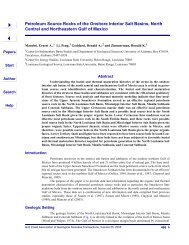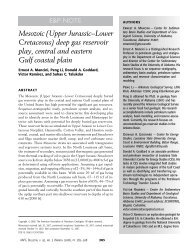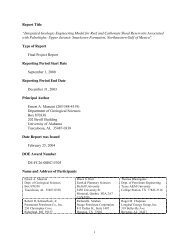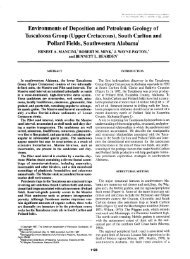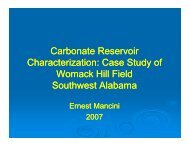Part 4 - Berg - Hughes Center
Part 4 - Berg - Hughes Center
Part 4 - Berg - Hughes Center
Create successful ePaper yourself
Turn your PDF publications into a flip-book with our unique Google optimized e-Paper software.
1987; Claypool and Mancini, 1989; Mancini et al., 2003, 2005, 2008). Present-day<br />
Smackover microbial and amorphous lime mudstone beds average less than 1% total<br />
organic carbon (Table 1). To adjust for the loss of organic carbon caused by the thermal<br />
maturation process, Li (2006) used the conversion of Daly and Edman (1987). The use of<br />
this conversion indicates that the original total organic carbon in the Smackover was<br />
reduced by 1.5 to 1.8 times during the thermal maturation process. Reservoir rocks<br />
include Upper Jurassic, Cretaceous, and Tertiary continental, coastal, nearshore, marine<br />
shelf, and deep-marine siliciclastics and nearshore marine, shelf, ramp, and reef<br />
carbonates (Mancini et al., 2003, 2008) (Fig. 328 and Table 3). Petroleum seal rocks<br />
consist of Upper Jurassic and Lower Cretaceous anhydrite and shale, Upper Cretaceous<br />
chalk and shale, and lower Tertiary shale (Mancini et al., 2003, 2008) (Fig. 328).<br />
Petroleum traps include structural, stratigraphic, and combination structural-stratigraphic.<br />
Salt related structures are common and consist of pillows and diapers (<strong>Hughes</strong>, 1968;<br />
Lobao and Pilger, 1985) (Figs. 329-332).<br />
Bossier Petroleum System<br />
Upper Jurassic (Tithonian) to Lower Cretaceous (Berriasian) Bossier shale beds<br />
have been described as source rocks in the East Texas Salt Basin by Ridgley et al. (2006),<br />
and Hermann et al. (1993) reported that gas in the Ruston Field of north Louisiana was<br />
sourced by Cotton Valley shale beds. A preliminary evaluation of the Bossier in the<br />
North Louisiana Salt Basin indicated that these shale beds were possible source rocks in<br />
this basin given the proper organic facies and sufficient total organic carbon contents for<br />
they have experienced the required thermal conditions for thermogenic hydrocarbon<br />
390




